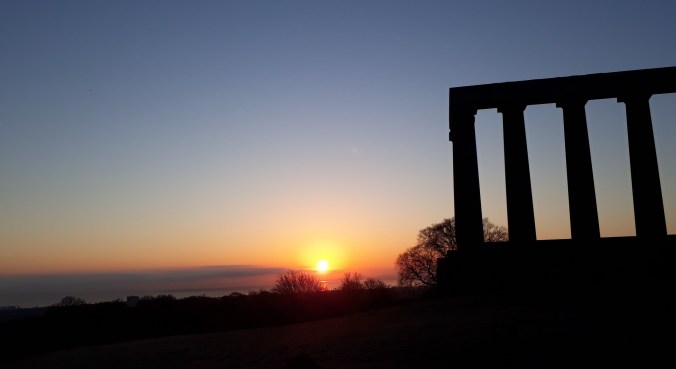A few weeks back, I attended the Joint BESTEG/gtö Symposium in one of the most beautiful cities of the British Isles (now just down the road from me) with a rich history of scientific endeavour. The British Ecological Society tends to put on a good show from my experience, and this met expectations. The Symposium was entitled “Unifying Tropical Ecology: Strengthening Collaborative Science”; the pertinence of which was emphasised in the Welcome Address by Pierre-Michel Forget, the Society of Tropical Ecology’s (gtö) President, as we head towards a potential division within European scientific institutions that will likely impact on all nations of Europe and beyond, unless we work hard to keep connections alive.

A picture from Calton Hill, pre-BESt jog. (Excuse the wonky angle – one of my fortes!)
There were many excellent talks, and I listened to some fascinating presentations about things I wasn’t even aware were a thing beforehand. I thought I’d give a quick low-down on some of my top tales from the meeting (mostly so I’ve got them recorded somewhere other than in my fraying notebook).
1. Open ecosystems need the Attenborough-effect, and fast
As Professor William Bond passionately described, these are ecosystems that naturally contain areas of non-woody vegetation. I’m sure I’ve not given his definition justice, but basically, the natural disturbance regime, coupled with climate and soil type, create an environment where trees are not the dominant vegetation type. I was fascinated to hear William describe fire as a biological agent in these landscapes; as the “life-blood” of most of the World’s open ecosystems. Yet, because of our preponderance for forest, and our perception that forest would dominate most ecosystems (within certain biophysical boundaries) if us humans hadn’t tampered with them, we are biased against seeing different landscape configurations, i.e. these precious open ecosystems. We’re not “seeing” them and understanding the ‘nature’ of these open systems because we consider them to be a result of our destructive behaviour, rather than natural. An example of this is the very recently ‘discovered’ and designated biodiversity hotspot in the USA: the North America Coastal Plain. As explained in this article: “several myths and misconceptions prevented ecologists and conservationists from recognizing the biological importance of the NACP until now”, its uniqueness and stability, absent of anthropogenic impact. One consequence of us not appreciating the uniqueness and importance of these ecosystems, is that we are all too ready to turn them into forests, encouraged by well-meaning, but somewhat naïve international initiatives such as The Bonn Challenge: “a global effort to bring 150 million hectares of the world’s deforested and degraded land into restoration by 2020, and 350 million hectares by 2030”. I think it’s a challenge in itself for any international initiative to avoid being naïve when it attempts to roll-out a one-size-fits-all across the globe; often in reality, one-size-fits-none (a common problem encountered with free t-shirts). Through the impetus of the Bonn Challenge, with careful planning, millions of hectares of recently deforested land could be replanted, i.e. reforestation. (Though see Wheeler et al.’s recent Comment pondering some of the specific challenges of the Challenge, including where all of this magical land for reforestation might be!) Afforestation – [converting] (land) into forest, especially for commercial exploitation – is a different matter altogether and requires a lot more consideration and perhaps guidance through policy, to ensure open ecosystems are not sacrificed in the process (and indeed, peatlands). Hmm….
2. Termites are really quite awesome
Yes, I’m late to the game on this one. Professor Kate Parr, through a rather annoying (at the time) and unpredicted environmental disaster, found out some fascinating new facts about these amazing creatures. A drought revealed to her and her crew that termites are more important than we previously realised in facilitating recovery in drought-disturbed forests, significantly increasing the resilience of the vegetation. This recent paper from her group gives much more background, and justice to the important role of termites than my few sentences. Kate ended her talk by cautioning that termites don’t seem to be able to survive in forests impacted by recurrent fire, or fire and drought, or the other forms of ‘unnatural’ disturbance common to the Anthropocene.
3. Unlike many humans, trees are taking action to respond to climate change
Emma Bush gave an excellent presentation explaining the data she has collecting that shows a reduction in leaf senescence as atmospheric CO2 levels rise, i.e. trees are holding onto their leaves for longer. Again, there’s way more of this story to tell (and I think Emma has a few outstanding research questions she’s wanting to answer), so keep an eye out for publications from this budding expert.
4. And a few more of the cool things I learnt:
- Trees don’t get on well without neighbours, as demonstrated by Isabel Jones, showing results of reduced regeneration of trees on islands created by the construction of mega-dams; more info here. I wondered what impact these dams were also having on the fauna of the now-fragmented landscape and consequently on seed dispersal for the trees, e.g. are they creating “silent forests”? But I sadly couldn’t find her at coffee to ask! Neat work.
- Talking of seed dispersal, Professor Kim McConkey, gave a really interesting plenary on the role of megafauna in seed and fruit evolution in the Tropics, and indeed the mysteries that still remain on that front. An impressive piece of detective work, involving many people over many years, as told in part here.
- Various presentations made me realise that the impact of drought on the vegetation of the forested Tropics is complex (yes, late to the game there too!). Different environmental and interacting factors make for a wide array of (sometimes unpredictable) responses of vegetation to the disturbance of drought. And ‘drought’ itself is a different beast in different ecosystems: one man’s drought is another man’s shower….or something like that.
- You can learn all sorts of things when you start a new project, or when an old project gets a bit fruity, with many outcomes being far from any hypotheses you might have scribbled down (sometimes post-hoc!)….if you keep your eyes and mind open!
- Having an early morning jog, around a beautiful city, with a bunch of other hungover ecologists, is a very great idea.
Thanks to the BES, and everyone else who joined in the fun.

Having fun with Project Awesome Edinburgh, at sunrise, on Calton Hill. They meet there every Wednesday. Well worth joining in.